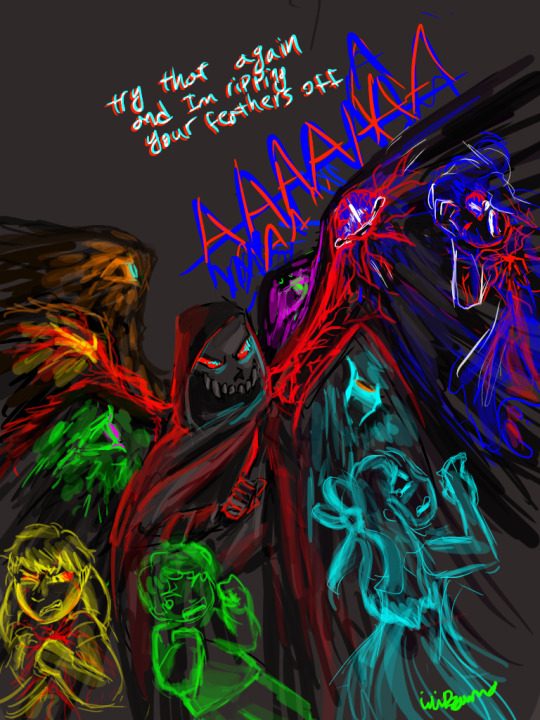#gorelike
Explore tagged Tumblr posts
Text

polish military courier
49 notes
·
View notes
Note
first of all, closure looks sick asf!!! secondly, I just wanted to know how all the souls feel about their new... predicament...? And also sans' opinion, if he even.. wants to talk at the moment? I'm overall very curious about everything

first<prev>next
well, he's busy arguing at the moment.
his brain is a chaotic mess of children either yelling at him, screaming in pain or him screaming in pain from the children yelling at him...
at least... when they're revolting or fighting for control. he can't control his temper because they are IN HIS MIND. and his bloodlust takes effect instantly before he can think twice and take it back like he can do when thoughts turn to actions.
the LV difference causes some... unforseen side effects that will cause psychological pain to the soul exposes to it. he has to actively block his magic flow to his wings to keep the souls sane and safe which... is kinda like blocking his bloodstream? he actively has to fight against his own body just to keep them in line, but also he's SICK of them disobeying.
they still aren't used to each other.
and while this may seem cruel, even for dust, sans just views them as parasites or "tools". he's CLOSED off his empathy because he's distrustful of them having ulterior motives.
he's also heavily biased against human children due to being repeatedly stabbed by one xxx times.
he TRIES not to resort to this. but whenever someone forces control from him? (even if it means to save him from death) they have hell to go through.
he didn't want her to save him. he doesn't want ANY of their help. he was going to do just fine alone.
how the SOULS feel about him differs.
🧡 : I wanna punch him in the face.
💛: I understand his perspective but I don't agree with his methods. he's a huge hypocrite and needs to be taken down.
💚: he's just hurt. I don't think he's evil. I want to help.
🩵: I wish he would just LISTEN. he's so ANNOYING!
💙: he's a coward and a liar... mostly to himself.
💜: he's scary. I don't like him.
#closure au#dusttale au#closure#seraphim dust#tw violence#tw slight gore#or at least gorelike imagery???#it's just his magic color it's not blood
22 notes
·
View notes
Note
for ask game: 3!!
3: A song that reminds you of summertime
oh hey it even embedded correctly this time. ANYWAY KRYZYSOWA NARZECZONA MY BELOVED its funny bc the song itself is completely unrelated to summer BUT its the one song i always sing with my friends both on camps and school trips since its such a classic....... so yeah
3 notes
·
View notes
Text
An animal board book two-fer from Katerina Gorelik
An animal board book two-fer from Katerina Gorelik @schifferkids
What Do Animals Eat? (Curious Creatures), by Katerina Gorelik, (Nov. 2022, Schiffer Publishing), $9.99, ISBN: 9780764365140 Ages 1-3 Schiffer has been publishing some great board books, and this duo of larger-format board books by Katerina Gorelik, originally published in France (2018), is the latest. What Do Animals Eat? uses high-contrast colorful images to introduce readers to different…

View On WordPress
#animals#board book#Curious Creatures#Katerina Gorelik#Schiffer Kids#What Do Animals Eat?#Where Do Animals Live?
0 notes
Text



Scythian gold knight 4th C. BCE. length cm 2,4; gr. 13,41; Swiss private collection, 1970s-1980s.
"It is difficult to reconstruct the organization of the Scythian army. Written sources confirm its division into cavalry and infantry, and this is not contradicted by archaeological data. Cavalry was the principle arm of the Scythians, as was typically the case among nomadic societies. Herodotus and Thucydides put it in a clear-cut way, stating that each Scythian warrior was a mounted archer. On the other hand, Diodorus Siculus wrote that in one particular battle the Scythians fielded twice as many foot as horse. This is not surprising, in fact; for Diodorus was dealing with events of the late 4th century, when the gradual transition from nomadic to sedentary life among the Scythians was becoming marked; and it should also be noted that the majority of the combatants in the battle he describes were drawn from areas where this process was especially advanced.
Throughout early Scythian history the overwhelming majority of the men were mounted; infantry consisted of the poorer Scythians, and levies from those settled tribes whose territory was nom dominated by the Scythians. Commoners from these vassal tribes, which were obliged to provide military service, served on foot, and their more well-to-do leaders in the cavalry.
The bulk of the cavalry was probably made up of lightly-armed warriors, protected by no more than fur or hide jackets and headgear. The shock force of the Scythian host was the professional, heavily-armed cavalry commanded by local princes. Both horses and riders were well protected. They fought in formation, under discipline, and brought to the battlefield considerable experience of warfare. The engagement opened with a shower of arrows and sling-stones, followed at closer range by darts and javelins. The heavy cavalry then charged in close formation, delivering the main blow on the center of the enemy's array. They were certainly capable of maneuver in battle, breaking through the enemy ranks, regrouping in the thick of the action, and changing direction to strike at the right place at the right time. When the enemy had been broken the lightly-armed mass of the Scythian horse closed in to finish them off."
-The Scythians 700-300 BC: Dr. E.V. Cernenko, Angus McBride, & Dr. M.V. Gorelik
#scythian#scythian gold#antiquities#artifacts#statue#sculpture#art#ancient art#history#ancient history#pagan#4th century bce
396 notes
·
View notes
Text

they look smashable and filled with roughly gorelike goop. im going to get a big hammer and crush all of them
4 notes
·
View notes
Text
youtube
Yiddish folk song performed by Alexandra Gorelik. The song expresses longing and nostalgia for a lost home, for old relatives and friends, for the Jewish shtetls, where there are no Jews left.
72 notes
·
View notes
Text

What interests me to underline, beyond the specificity of each context, is how [Argentina and Brazil's] centenaries take place in a climate of political instability – both celebrations take place under a state of siege– simultaneously with a triumphalist state will to celebrate. As Adrián Gorelik observes for Argentina, the centenary celebration, far from hiding the conflicts behind their masks, puts them in the most visible place: the public space. Paradoxically, the demonstrations and protests of organized groups such as those acting in Buenos Aires were a sign perceived as one of the desirable effects of modernization: even with their threatening burden, they strengthened the perception of a disciplined mass, preferable to chaotic and unpredictable offense.
Thus, although the centenary exhibitions sought to show an image of prosperity and institutional solidity, they allow us to recognize, rather, an effort to sustain a worn-out political system, on the eve of change and subjected to a strong offensive, both from the left by anarchists and socialists, as well as by traditionalist sectors that in Brazil and Argentina defended the cultural heritage of the deep interior, in opposition to the cosmopolitan, parasitic and foreignizing coastline. What they questioned was the visible image of the nation, and in particular the image of the capital cities – Europeanized and Europeanizing – associated with falsehood and disinterest in the authentic national culture. As scholars of the phenomenon have pointed out, it is the sensation of the danger of loss that triggers a heritage discourse and enables the formation of a suddenly threatened material heritage. The notion of heritage as a collective good associated with the national feeling is initially produced from a feeling of loss, as it emerged after the French Revolution.
Fernández Bravo, Álvaro (2011). Celebraciones centenarias: nacionalismo y cosmopolitismo en las conmemoraciones de la Independencia. Buenos Aires, 1910 – Río de Janeiro, 1922
#for more context: argentina was in the middle of an economic crisis and there was a strike days before the celebrations begun#Celebraciones centenarias: nacionalismo y cosmopolitismo en las conmemoraciones de la Independencia#centenario
3 notes
·
View notes
Text
youtube
Ernst von Dohnányi (1877-1960) : Violin Sonata in c sharp minor Op. 21
Live performance by members of Urban Nocturnes, at Trinity Episcopal Cathedral in downtown Phoenix, AZ, November 2, 2023.
Karen Sinclair, violin Olga Gorelik, piano
1 note
·
View note
Text

justice society beach potluck
#dc#justice society#courtney whitmore#kara zor el#dinah lance#oliver queen#judyta gorelik#anatoly skok#kadir al-hal#ted grant#ray palmer#power girl#stargirl#black canary#green arrow#sentinel#piorun#hawkman#wildcat#the atom#wendy west#the flash#linda park west
43 notes
·
View notes
Text
Art is from the book “Look Through the Window” by Katerina Gorelik

0 notes
Note
trick or treat ^_^
REJOICE! PAPITA BE UPON YE

2 notes
·
View notes
Text


Playful Fish
designed by Roman & Lev Gorelik
0 notes
Text
>> ARD Radio Kulturevent
Ein Käfig ging einen Vogel suchen.
Ein Franz-Kafka-Abend mit Lena Gorelik, Jella Haase und Sven Regener Moderation: Natascha Freundel und Thomas Böhm (Liveübertragung aus dem großen Sendesaal im RBB) <<
0 notes
